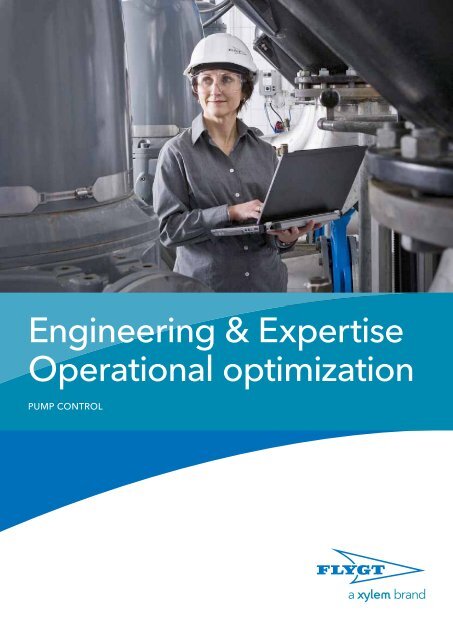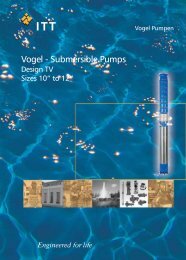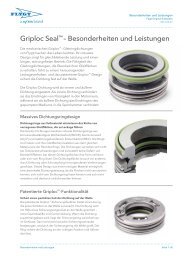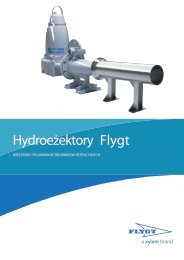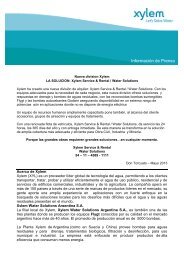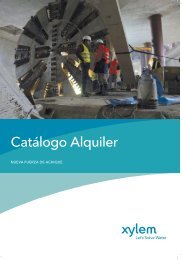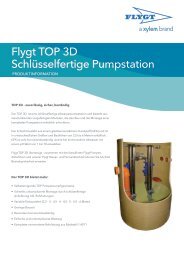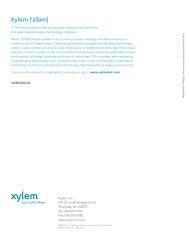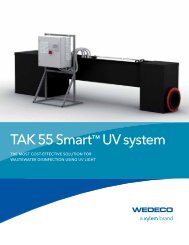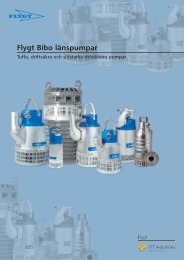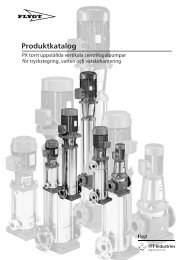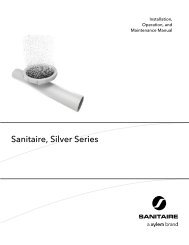Pump control - Flygt
Pump control - Flygt
Pump control - Flygt
You also want an ePaper? Increase the reach of your titles
YUMPU automatically turns print PDFs into web optimized ePapers that Google loves.
Engineering & Expertise<br />
Operational optimization<br />
<strong>Pump</strong> <strong>control</strong>
Engineering & Expertise<br />
Total solution engineering<br />
increases operational efficiency<br />
Introduction<br />
Determining the right <strong>control</strong> philosophy for<br />
pump operation is a critical factor to ensure<br />
the lowest life cycle cost of the entire pump<br />
system. Proper management reduces the risk<br />
of physical impediments, such as sedimentation,<br />
clogging and floating debris, as well as<br />
cuts energy costs and increases equipment<br />
service life.<br />
Engineering expertise is required in order to<br />
realize energy, operation and maintenance<br />
cost-savings through proper pump <strong>control</strong>. We<br />
will provide guidance for the design of pump<br />
<strong>control</strong> systems based on pump <strong>control</strong> theory<br />
as well as years of experience from a number<br />
of applications. Various <strong>control</strong> philosophies<br />
are discussed in order to achieve an efficient<br />
pump <strong>control</strong>.<br />
Achieving lowest total cost of ownership<br />
When providing pumping solutions, <strong>Flygt</strong> prefers to<br />
take the total cost of ownership into consideration.<br />
Unplanned<br />
Investment<br />
Operational<br />
• Investment costs<br />
Costs associated with design, excavation, civil work,<br />
product purchases, installation and commissioning.<br />
• Operational costs<br />
Over time, energy usage and maintenance costs<br />
are often the major contributors to the overall costs<br />
along with the cost of labor required to run the<br />
system.<br />
• Unplanned costs<br />
When things go wrong, such as pump failures stemming<br />
from problematic station design, costs can<br />
sky rocket. Unexpected downtime can cause sewer<br />
backups, overflows, basement flooding and untreated<br />
effluent. On top of that, you have to repair<br />
pumps and take corrective measures regarding the<br />
station design.<br />
Theoretical analysis<br />
Products<br />
Physical tests<br />
Engineering & Expertise<br />
Thanks to our engineering expertise, we can lower<br />
your total cost of ownership. We can analyze your<br />
system using state-of-the-art computational programs.<br />
We can test your pump station using scale<br />
models if required. We can also provide you with<br />
reference installations that are similar to your project.<br />
All of this together with our premium products<br />
provides you with an optimized design.<br />
Reference installations<br />
Engineering & Expertise<br />
2
Introduction<br />
Understanding the importance<br />
of pump <strong>control</strong><br />
Poorly designed pump <strong>control</strong> systems can have adverse<br />
effects on the entire pump system. This can<br />
lead to the increased risk of sediment buildup in<br />
pipes and sumps as well as clogging of the pumps.<br />
Incorrect operating levels in the sump and velocities<br />
in the pipes that are too high can significantly<br />
increase energy consumption and costs. Equipment<br />
lifetime may also be reduced due to transient effects<br />
that result from high pressure at pump stops as well<br />
as reduced pump motor lifetime due to starting and<br />
stopping.<br />
<strong>Flygt</strong> pump <strong>control</strong><br />
To optimize pump system operation, we take a<br />
comprehensive approach to supplying complete<br />
water and wastewater systems, including a broad<br />
range of pump monitoring and <strong>control</strong> systems for<br />
various pumping applications. These pump <strong>control</strong><br />
solutions are designed to deliver substantial energy<br />
savings, by offering increased protection against<br />
pump failure due to clogging and sedimentation,<br />
lower maintenance costs and increased operational<br />
efficiencies.<br />
With our pump <strong>control</strong> philosophies, we offer different<br />
levels of <strong>control</strong> and corresponding functions<br />
through the <strong>Flygt</strong> pump <strong>control</strong> portfolio of<br />
products. These levels range from local equipment<br />
<strong>control</strong> to full <strong>control</strong> throughout the system and ultimately<br />
to multi-site <strong>control</strong> of the entire plant. The<br />
broad range of <strong>Flygt</strong> pump <strong>control</strong>s available within<br />
the portfolio enables us to tailor a pump <strong>control</strong> solution<br />
to meet the specific requirements of various<br />
applications.<br />
Application-specific products<br />
Good pump station design takes into account all the individual<br />
system components – including pumps, sump,<br />
pipe installation and operating <strong>control</strong>s – as well as the<br />
interaction among these. This ensures that all components<br />
work in unison to deliver highly efficient operation<br />
at the lowest possible total cost of ownership. As a<br />
single reliable supplier, <strong>Flygt</strong> offers application-specific<br />
products – from level switches to advanced SCADA<br />
<strong>control</strong> systems – to ensure the most suitable type of<br />
pump <strong>control</strong> for every application.<br />
3
<strong>Pump</strong> <strong>control</strong> philosophies<br />
<strong>Pump</strong> <strong>control</strong> affects<br />
the entire system<br />
Inlet<br />
Challenges<br />
When deciding upon <strong>control</strong> strategy the inlet<br />
pipe’s vertical position must be taken into consideration.<br />
If the inlet pipe is submerged during periods<br />
of operation the fluid velocity will decrease and<br />
there will be an increased risk for sedimentation.<br />
On the other hand, when fluid levels in the sump<br />
are too low, the static head will increase, thereby increasing<br />
energy costs.<br />
<strong>Pump</strong> <strong>control</strong> affects the operational efficiency of<br />
the entire pump system – from the inlet, through<br />
the sump and to the pump and the force main or<br />
rising main. It is therefore important to understand<br />
the interaction of all components with the pumped<br />
fluid. Risk factors such as transients, clogging,<br />
floating debris and sedimentation buildup must be<br />
taken in account. Our pump <strong>control</strong> philosophies<br />
solve the challenges related to each part of the<br />
system by offering different levels of <strong>control</strong> and<br />
corresponding functions selected from within the<br />
<strong>Flygt</strong> portfolio of pump <strong>control</strong> products.<br />
Solutions<br />
To ensure the selection of the right start level, it<br />
is important to understand the approach conditions<br />
of the system prior to the station. The right<br />
start level will prevent flooding in other parts of<br />
the system, and reduce the energy consumption<br />
related to the static head and number of operating<br />
hours. Our expertise and experience ensure that<br />
the right <strong>control</strong>ler is selected to deliver reliable,<br />
energy-efficient pump operation.<br />
Non-submerged inlet.<br />
Submerged inlet.<br />
4
<strong>Pump</strong><br />
Challenges<br />
Proper submergence of the pump inlet must be fulfilled<br />
to prevent the risk of fully developed surface<br />
vortices. Cavitation problems due to insufficient<br />
available net positive suction head (NPSH) also have<br />
to be avoided when choosing the stop level. These<br />
phenomena can lead to vibrations and wear on<br />
the pumps, shortening their lifetime. Stopping all<br />
pumps at the same time should be avoided in large<br />
systems with long force main pipes since this instigates<br />
unnecessary pressure transients.<br />
Solutions<br />
For standard sump configurations, the recommended<br />
minimum submergence requirements can<br />
be found in “Design recommendation for pump<br />
stations” for all <strong>Flygt</strong> pumps. It is also important to<br />
ensure that the NPSH requirement is met.<br />
In a multiple pump station, the pumps can be<br />
stopped at sequential stop levels or with a time<br />
delay between stops depending on the station conditions.<br />
It is especially important with time delays between<br />
the stops in large systems, in order to prevent<br />
high immediate flow changes from developing into<br />
pressure transients in the force main pipes. The <strong>Flygt</strong><br />
<strong>control</strong>lers have different built-in functions and can be<br />
adapted to different types of systems, including multiple<br />
pump installations.<br />
<strong>Pump</strong>s with variable frequency drives<br />
<strong>Pump</strong>s with variable frequency drives<br />
Challenges<br />
<strong>Pump</strong>s with variable frequency drives have an increased<br />
risk of clogging in the pump due to the decreased<br />
impeller speed during pump operation. The<br />
decreasing impeller speed at ramp down also drastically<br />
reduces the self-cleaning effect that occurs naturally<br />
when back flushing, a phenomena that occurs<br />
when the pump comes to a hard stop.<br />
Solutions<br />
To prevent clogging in pumps with variable frequency<br />
drives, an impeller cleaning cycle is recommended.<br />
Integrated logic enables monitoring of the pump for<br />
signs of clogging. Upon detection of clogging, the<br />
pump auto matically stops and begins to operate in reverse<br />
rotation to remove the blockage. <strong>Pump</strong> cleaning<br />
cycles are integrated into <strong>Flygt</strong> pump drives.<br />
(Note: <strong>Pump</strong> cleaning cycles are not applicable on <strong>Flygt</strong> propeller pumps,<br />
which are not designed for reverse rotation).<br />
A clogged pump.<br />
I Speed +<br />
Illustration of the cleaning cycle.<br />
5
<strong>Pump</strong> <strong>control</strong> philosophies<br />
Sump<br />
Challenges<br />
To keep the sump clean it is crucial that everything<br />
entering the sump is pumped away. Low flow regions<br />
create stagnation zones in the sump where<br />
bottom sediments and floating debris build up.<br />
Solutions<br />
Alternation<br />
Automatic duty pump alternation is one method to<br />
prevent stagnant zones in the sump. Alternation of<br />
pumps implies equal running hours for all pumps<br />
and reduces the number of start and stops per<br />
hour. Alternation is also a good way to frequently<br />
exercise all pumps installed. The alternation function<br />
is built into <strong>Flygt</strong> pump <strong>control</strong>lers.<br />
Sump cleaning cycles<br />
Sump cleaning cycles are used to prevent odor<br />
and the buildup of floating debris in the sump. It<br />
is important to clean the sump on a regular basis.<br />
Frequent cleaning cycles are recommended, where<br />
the sump water level is pumped down below the<br />
normal stop level until the pumps are snoring. All<br />
floating debris will then be removed from the sump<br />
by the pumps. Cleaning cycle functions are built<br />
into <strong>Flygt</strong> pump <strong>control</strong>lers.<br />
Active sump volume<br />
The active sump volume is the volume between the<br />
start and the stop level. When analyzing the active<br />
sump volume, it is important to ensure that the volume<br />
is sufficiently large enough to prevent the pumps from<br />
starting too often. However, each time the pumps are<br />
stopped they are backflushed, cleaning the pump<br />
which is desirable. The active sump volume should<br />
therefore be large enough to ensure that the pumps<br />
do not start too often, but small enough to ensure that<br />
the pumps are cleaned frequently.<br />
Force main<br />
The fluid velocity in the force main affects both the<br />
degree of sedimentation and the energy consumption,<br />
where the two are contradictive. At high velocities<br />
the energy consumption increases but the<br />
risk of sedimentation problems are low. In contrast,<br />
when the velocity is low the energy consumption<br />
will be low but the risk of sedimentation is increased.<br />
Both the risk of sedimentation and energy<br />
consumption should be considered when deciding<br />
on <strong>control</strong> philosophies.<br />
Sedimentation<br />
problem<br />
Energy consumption<br />
Fluid velocity<br />
Example of rugs and soft solids developing a surface mat.<br />
When determining the optimal fluid velocity, it is important<br />
to consider both sedimentation problems and energy<br />
consumption.<br />
6
Complete system<br />
Challenges<br />
In addition to the steady state pump duty analysis, it<br />
is important to analyze the pump system with start<br />
calculations and water hammer analysis. This will<br />
ensure a sufficient starting torque, properly dimensioned<br />
backup power supply, reliable pump duty<br />
and protection against water hammer.<br />
Solutions<br />
Start calculations<br />
Start calculations are recommended for large<br />
pumps, and especially for propeller pumps due to<br />
their torque characteristics. Start calculations will<br />
indicate if there is sufficient torque margin between<br />
the motor torque and the system load torque. The<br />
calculations will also show if the motor is overloaded<br />
during start. We design and manufacture our<br />
own motors and have complete knowledge of their<br />
motor characteristics, which implies very accurate<br />
start calculations.<br />
Duty analysis<br />
To ensure sufficient NPSH, adequate rated motor<br />
power and high pump efficiency, it is necessary to<br />
conduct duty analysis. A duty analysis presents scenarios<br />
where different pumps are running over the<br />
system’s range of static heads, with various levels of<br />
regulation and at varying speeds. This is important in<br />
order to save energy and increase reliability. We have<br />
developed our own tools to suit our pumps and applications<br />
for basic and advanced duty analysis.<br />
Water hammer analysis<br />
To determine whether a system is susceptible to the<br />
effects of water hammer, it is necessary to conduct<br />
a water hammer analysis and, if required, to evaluate<br />
the different methods of protection and select<br />
and install the right methods. We can perform accurate<br />
water hammer calculations, thanks to our extensive<br />
testing of <strong>Flygt</strong> pumps and vast experience<br />
with state-of-the-art mathematical modeling.<br />
Water hammer analysis graphs from the <strong>Flygt</strong> Engineering Tool.<br />
Start calculation graphs from the <strong>Flygt</strong> Engineering Tool.<br />
7
<strong>Flygt</strong> pump <strong>control</strong> solutions<br />
Optimizing pump<br />
<strong>control</strong> systems<br />
To provide the optimal solution for pump <strong>control</strong><br />
systems, it is necessary to take a total systems<br />
engineering approach. We have the advanced<br />
engineering software to assist with the conceptual<br />
design of the <strong>control</strong> system, the practical<br />
know-how and facilities for physical testing of the<br />
<strong>control</strong> system as well as the engineering experience<br />
and comprehensive portfolio of <strong>Flygt</strong> pump<br />
<strong>control</strong> products.<br />
Theoretical analysis<br />
We develop our own engineering software, which<br />
enables simulation of the pump system before it is<br />
installed and commissioned. Simulation of the start<br />
and stop of the system is critical from many perspectives,<br />
such as pressure transients and sufficient motor<br />
torque. With our knowledge and our tools, we can<br />
help design reliable, energy-efficient systems. For<br />
large custom designs or troubleshooting we perform<br />
a computational fluid dynamics simulation study when<br />
necessary to gain the complete picture of the flow<br />
patterns inside the sump.<br />
Premium products<br />
We offer comprehensive solutions for pump <strong>control</strong><br />
based on our broad portfolio of <strong>Flygt</strong> pump <strong>control</strong><br />
hardware and software. Depending on the application,<br />
our offerings range from standard setups<br />
to programmable custom solutions and systems<br />
for use in hazardous environments. These include,<br />
but are not limited to, the following functions and<br />
alarms:<br />
• Alarm logs<br />
• Start and running time counters<br />
• High and low level alarms<br />
• Power failure<br />
• Personal alarms<br />
• <strong>Pump</strong> capacity calculation<br />
• Random start levels<br />
• Dry run protection<br />
• Constant level <strong>control</strong><br />
• Communication with SCADA, radio, ethernet cellular<br />
systems and telephone lines<br />
Physical testing<br />
We have vast experience gained from testing<br />
different <strong>control</strong> philosophies in a <strong>control</strong>led environment<br />
through small-scale model tests. When<br />
designing large custom stations, it may be necessary<br />
to conduct specific small-scale model tests to<br />
analyze the <strong>control</strong> philosophy and ensure that no<br />
adverse hydraulic issues arise.<br />
8
Reference installations<br />
Proven worldwide<br />
<strong>Flygt</strong> has applied our pump <strong>control</strong> philosophies<br />
together with our premium products on thousands<br />
of installations around the world. Engineering expertise<br />
and years of experience have resulted in the<br />
success of these installations. Two such cases are<br />
described below.<br />
Sweden: <strong>Pump</strong> station<br />
Challenge<br />
Eighteen <strong>Flygt</strong> pump stations transport wastewater at<br />
a popular recreational and amusement area in central<br />
Stockholm. One of the pump stations handles restaurant<br />
wastewater containing fats, oils and grease.<br />
The liquefied oil and grease in high-temperature<br />
dishwashing water solidifies after transportation to<br />
the pump station. This caused severe odor problems<br />
and grease build-up on the pump station walls, sump<br />
water surface, <strong>Flygt</strong> CP3102 pumps, guide bars, level<br />
sensor and other pump station equipment, increasing<br />
the risk of failure in the station. Expensive maintenance<br />
procedures had to be carried out every two to<br />
three months in order to remove accumulated sludge<br />
and clear the station of greasy buildup.<br />
Solution<br />
Our engineers recommended the installation of a<br />
<strong>Flygt</strong> APF cleaning function through an electronic<br />
device for automatic pump sump cleaning. The <strong>control</strong>ler<br />
automatically initiates pump operation in order<br />
to drain sump water to the lowest possible level,<br />
thereby removing grease and dirt laying on the surface<br />
of the water. This enables the pump station to<br />
operate for a significantly longer time without requiring<br />
any sludge removal.<br />
United Kingdom: More energy-efficient pump station<br />
Challenge<br />
Four high-efficiency 100 kW <strong>Flygt</strong> N-pumps operating<br />
with variable frequency drives (VFDs) deliver<br />
a total volume of 0.8 m 3 /s (12,700 US gpm) and<br />
consume 1,000,000 kWh of energy per year. The<br />
customer wanted to reduce energy costs but maintain<br />
reliable, trouble-free operation without the<br />
problems of clogging, sedimentation and floating<br />
debris.<br />
Solution<br />
We performed an energy audit by measuring flow,<br />
head, power and analyzing the <strong>control</strong> philosophy.<br />
By analyzing the results from the measurements,<br />
we identified that adjustment of the settings on the<br />
VFDs would lead to more energy-efficient operations.<br />
Estimated energy savings amounted to between<br />
five and 15 percent.<br />
9
Services AND support<br />
Engineering & Expertise<br />
To ensure reliable and highly efficient operation,<br />
we offer comprehensive support and service for<br />
pump station design, system analysis, installation,<br />
commissioning, operation and maintenance.<br />
Design tools<br />
When you design pump stations, we can offer<br />
advanced engineering tools to generate sump<br />
designs. Our design recommendations give you<br />
essential information regarding dimensions and<br />
layout. In short, we assist you every step of the<br />
way to make sure you optimize performance and<br />
achieve energy-efficient operations.<br />
Theoretical analysis<br />
Computational fluid dynamics (CFD) can provide far<br />
more detailed information about the flow field in a<br />
fraction of the time required to get the same information<br />
through physical hydraulic scale model testing.<br />
Using CFD in combination with computer-aided<br />
design (CAD) tools, it is possible to obtain a more<br />
efficient method of numerical simulation for pump<br />
station design.<br />
To obtain a reliable, energy-efficient pumping<br />
system, it is important to analyze all modes of operation.<br />
To analyze the transient effects at pump<br />
start and stop with respect to flow and head as<br />
well as the electrical parameters such as current<br />
and torque, it is also important to have an accurate<br />
mathematical description of the pump and motor,<br />
which is gained, in part, from extensive testing in<br />
our laboratories.<br />
10
Physical testing<br />
Physical hydraulic scale model testing can provide<br />
reliable, cost-effective solutions to complex hydraulic<br />
problems. This is particularly true for pump stations<br />
in which the geometry departs from recommended<br />
standards or where no prior experience with the<br />
application exists. Scale model testing can also be<br />
employed to identify solutions for existing installations<br />
and has proven to be a far less expensive way<br />
to determine the viability of possible solutions than<br />
through trial and error at full scale.<br />
Reference installations<br />
We have conducted system analysis and designed<br />
pump stations for thousands of installations around<br />
the world. Engineering expertise and years of experience<br />
gained from the design and operation of these<br />
installations have been a critical success factor when<br />
analyzing, testing and commissioning new pump<br />
installations.<br />
When our standard design recommendations are<br />
not met, we can assist in determining the need for<br />
physical testing as well as planning and arranging<br />
the testing and evaluating the results.<br />
Theoretical analysis<br />
Products<br />
Physical tests<br />
Reference installations<br />
Engineering & Expertise<br />
Model test photos courtesy of Hydrotec Consultants Ltd.<br />
11
1) The tissue in plants that brings water upward from the roots<br />
2) A leading global water technology company<br />
We’re 12,000 people unified in a common purpose: creating innovative solutions<br />
to meet our world’s water needs. Developing new technologies that will improve<br />
the way water is used, conserved, and re-used in the future is central to our work.<br />
We move, treat, analyze, and return water to the environment, and we help people<br />
use water efficiently, in their homes, buildings, factories and farms. In more than<br />
150 countries, we have strong, long-standing relationships with customers who<br />
know us for our powerful combination of leading product brands and applications<br />
expertise, backed by a legacy of innovation.<br />
1203 . Operational optimization . 1 . Master . 1 . 20120419<br />
For more information on how Xylem can help you, go to xyleminc.com.<br />
<strong>Flygt</strong> is a brand of Xylem. For the latest<br />
version of this document and more<br />
information about <strong>Flygt</strong> products visit<br />
www.flygt.com


